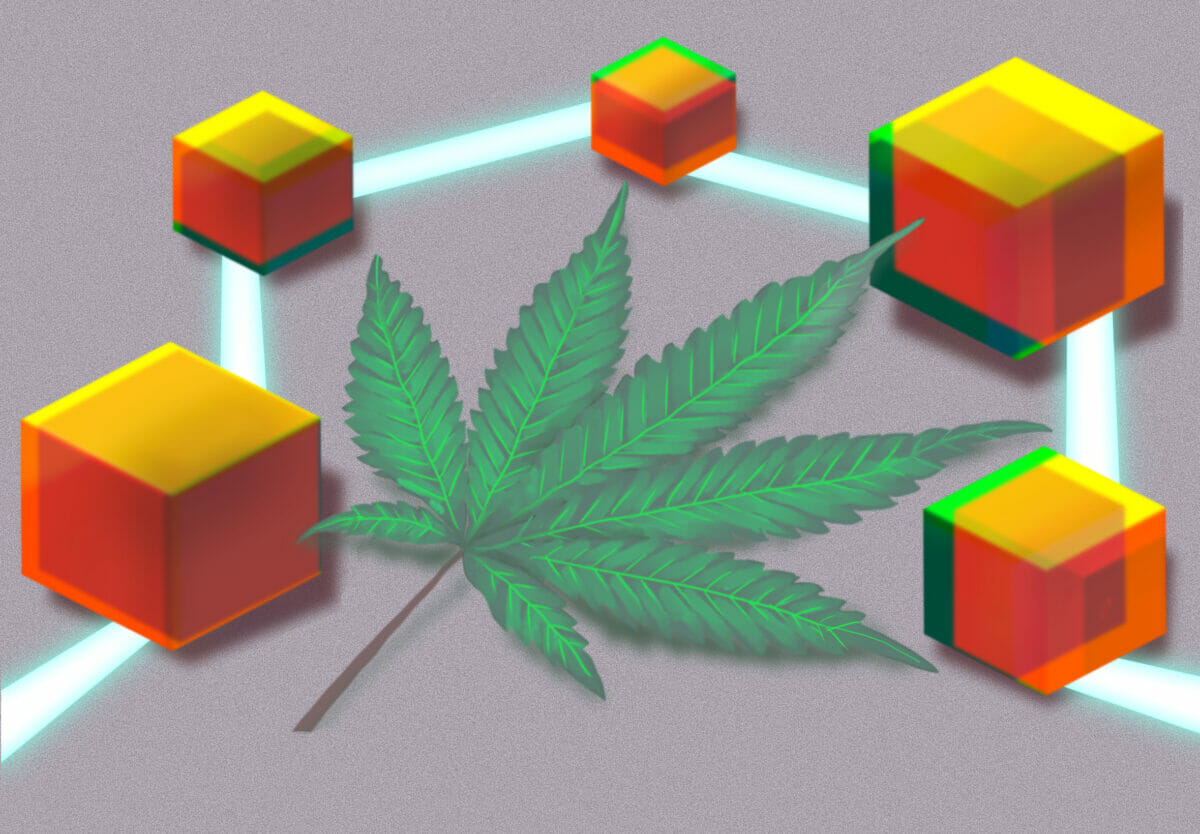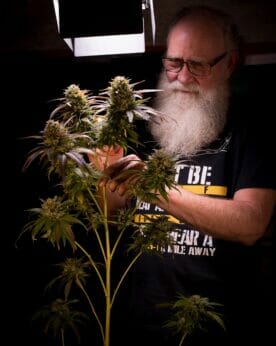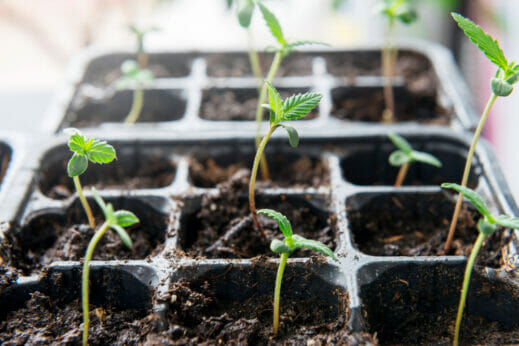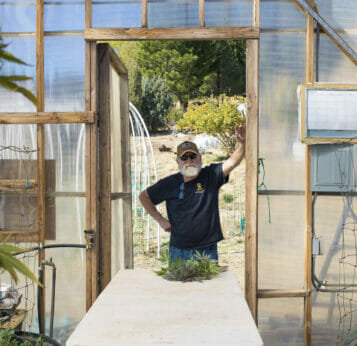Cannabis often has a hazy supply chain, but blockchain technology promises seed-to-sale transparency for growers and consumers.

Even though cannabis is now fully legal in 24 states, there’s often a smoky cloud shrouding its provenance. Dispensaries may charge a premium for heritage strains or sun-grown, organic weed, but a hazy supply chain can obscure a lot between seed and sale. “Consumers have no idea what’s going on behind the scenes,” says Eric Kennedy, co-founder of EMTRI Corp, a three-year-old company implementing blockchain technology into the cannabis industry.
From breeding and cultivation to testing and delivery, the cannabis blockchain captures a digital snapshot of every major step of production, distribution and sale, locking them into an immutable digital ledger. By leaving a transparent data trail that originates at the farm and ends with the buyer, the openly visible platform promises clear accountability of sourcing and product safety, as well as fair compensation and due credit.
Still, for a community with a long history of operating in the shadows, the budding technology has drawn its share of skeptics. Greater transparency, however, is paramount to protecting the livelihood of small-scale, legacy cultivators, says Kennedy, as many get priced out of a crowded market—one increasingly dominated by large and, at times, unscrupulous players. Opening the books boosts the integrity of small batch producers, he adds, and keeps them better connected to aficionados who appreciate their craft.
“Most deals are done with a handshake and loose contract,” adds Kennedy. “This sets everything in stone”—for all to see.
An open ledger
With supply chains becoming ever more complex, tracking the source and path of agricultural products is essential to food safety and quality. Yet, companies can be hard-pressed to trace, say, lettuce in a salad mix back to a specific farm, while farmers may be just as unclear about where their crops end up. Consumers also take a leap of faith when buying products that carry nebulous claims of being sustainably grown, ethically sourced or humanely raised—all of which can cast doubt on the true appellation of San Marzano tomatoes or who really benefits from fair trade coffee.
Blockchain technology can keep tabs on any number of defined points along the supply chain, with a time-stamped certificate capturing everything from crop genetics and field location to compliance history and packaging details. At each stage, users upload an indelible block of information to a decentralized ledger, one mirrored across a network of computers, with easy and speedy access.
The open-source system is fundamentally democratic, says Daniela Barbosa, executive director of the Hyperledger Foundation. As an umbrella project of the non-profit Linux Foundation, the organization supports and coordinates the collaborative development of blockchain technology. Although user communities and enterprises can develop distinct platforms, there’s no single company driving its development, she explains in an email, and “the code is there for anyone to use and adapt.”
Absent a centralized certificate authority and a singular database, all data are verified through consensus mechanisms, or rules and protocols that validate each transaction, which reduces the risk of cyberattacks and insider fraud. Some validation methods require heavy computation—Bitcoin, a digital currency built on blockchain technology, is notoriously energy-intensive in this regard—but those used in supply chains are much lighter on the grid, says Barbosa.
By scanning QR codes or other tags with smartphones, most food producers, sellers and buyers can readily tap into an established blockchain platform. The low technical and economic bar “wrings out costs,” she notes, “and helps make issues such as ethical and sustainable sourcing real.”
Nevertheless, even the best technology can’t absolutely guarantee that crops weren’t grown on razed rainforests or harvested with child labor. While the blockchain adds transparency to the process, every step including tagging, sensors and inspections needs to be well designed and implemented, says Barbosa. “Garbage in means garbage out,” she adds; in other words, the quality of output depends on the structure of the input.
A full seed-to-sale account
The recent spread of legal cannabis throughout pockets of the U.S. elicited high hopes for bolstering the supply of high-grade weed. Yet, amid skyrocketing demand—in 2020, nationwide sales increased by 67 percent—the field has become flooded with greater numbers of large-scale producers, resulting in a market glut and a collapse in wholesale prices, with little oversight of quality standards.
In California, which produces nearly 60 percent of the nation’s total yield, the state’s excessive taxes and regulations have hit small-scale cannabis farmers particularly hard, including industry veterans in the fertile Emerald Triangle of Humboldt, Trinity and Mendocino counties. Many of the area’s 20,000 estimated growers have operated in this remote Northern California region for decades—either under the radar or under Proposition 215, a somewhat vague law that legalized medical cannabis in the state in 1996—but have made significant investments to bring their business completely above board since full legalization in 2016.
These legacy farmers have long set the benchmark for quality, says EMTRI’s Kennedy. “These guys are producing sun-and-earth grown, medicinal grade cannabis” sustainably, in small batches. “We want to keep them at the top of the food chain,” he says.

Doc Ray has been breeding and cultivating medical cannabis strains for nearly 50 years. (Photo courtesy of Doc Ray)
Along with most other states where cannabis is legal, California relies on Marijuana Enforcement Tracking Reporting Compliance (METRC), a government-contracted enterprise system, to monitor and regulate various aspects of production, distribution and sales. METRC maintains records such as the Certificate of Analysis (COA), the official test results of a given harvest that includes cannabinoid content and any presence of pesticide, herbicide and toxin residues.
However, there’s little transparency built into the centralized platform, says Kennedy. With hazy quarantine periods for COA testing, no open access to records and data entered manually, the system leaves huge room for error, and even manipulation. The industry lacks standards for differentiating between medical and recreational strains or indoor and sun-grown products, he adds, creating challenges in verifying the value, authenticity or even the shelf-life of artisanal cannabis.
“We want farmers to maximize on their grow methods, on their IP [intellectual property],” says Kennedy. Legacy growers tend to “really care about the land,” relying on the sun and rich soil to cultivate a single annual harvest. And over the years, many have developed specialized varietals, fine-tuning aroma and flavor as well as the chemical profiles responsible for the psychoactive and therapeutic properties of cannabis.
These heirloom strains, which include legendary buds such as Blue Skunk and Girl Scout Cookies, “represent the extensive handiwork of breeders,” says Jed Davis, farmer and owner of Mendocino Clone Company, a commercial nursery supplying cloned, or propagated, cannabis seedlings. Yet those breeders have few measures in staking their claim, he says. “Once you give [the plant] to someone else to grow, that person can easily change the name,” take credit for the cultivar or cross-breed it into a new varietal. Consumers are often in the dark about what they’re truly smoking, he adds, noting that the industry is rife with questionable farming methods, product potency and safety issues.

Cannabis seedlings. (Photo: Shutterstock)
Earlier this year, Davis started tracking his seedlings on the blockchain. Each plant receives a unique block identity that stores its history accessible via a tagged QR code, starting with its origin and genetic heritage. As it moves along the chain of custody, growers add timestamped documentation of farm and location, a timeline of inputs, planting and harvest dates and even photographs. By the time it reaches the dispensary, a customer can pull up a bud’s full profile, including COA results, organic certification and shelf life, all via a simple scan.
In addition to providing a full seed-to-sale account, the secure open ledger “guarantees the customer that they know what they’re buying, where it came from and how it’s been cultivated,” says Davis. The assurance also helps build brand loyalty, he notes, while the ability for end users to leave reviews on the platform gives the farmer a feedback loop.
Growers also receive a financial incentive to join the blockchain via EMTRI’s own cryptocurrency. Similar to receiving company equity for each transaction, the virtual reward could provide a nest egg as well as a hedge against crop damage and other unforeseen circumstances. (Unlike cannabis farmed indoors, sun-grown crops are much more costly to insure; the lack of federal recognition also makes cannabis ineligible for U.S. assistance programs.)
Ultimately, the onus of honestly capturing the various steps falls on the individual players, says Davis. Although certain attestations can be collaborated with COA results, he sees an open ledger encouraging public accountability. “A lot of [small-scale] cultivators take a lot of pride in their craft,” he adds, and cherish their reputation as responsible farmers. “And that’s what a lot of customers really want to see.”
Building the chain of trust
Ironically, the wide-open nature of the platform may be off-putting to those in the field. “This community’s already leery of all that kind of stuff,” says Doc Ray, founder of Doc Ray Genetics, who still goes by his nickname—a common practice in the days before legalization. The self-professed old-timer has been breeding and cultivating medical cannabis strains for nearly 50 years, and was one of the first to openly farm cannabis under Prop 215.
Despite the seemingly straightforward and secure nature of the blockchain, many are wary of registering personal information tied to an industry with no federal recognition. And it’s no wonder, says Ray, recalling the era of federal raids on pot farms. “We’re the ones that have been handcuffed, had our kids displaced and our possessions taken from us.” (Although users can operate anonymously or under an account name, they still need to register an account on the platform; anti-money laundering regulations further require identity verification when handling cryptocurrency.)

Doc Ray, a self-professed old-timer, is an advocate of IP protection in the cannabis industry. (Photo courtesy of Doc Ray)
Ray holds several genetic patents on his cultivars (developed for his fellow veterans, some hold cult status for providing relief from post-traumatic stress, pain and insomnia) and is an ardent advocate of IP protection. And while he believes that the transparent nature of the blockchain is a valuable tool for staking public claims, the chain of trust, he adds, “is only as good as the operators on both sides of the coin.”
Patent infringement runs rampant these days, says Ray. “Even though we used to be the outlaws, we at least had a code of honor and rules that we lived by.” The boom in legalized recreational cannabis has emboldened many unscrupulous players, and most small-scale farmers lack the resources to go after the law breakers. “It’s just a brutal time right now for the craft cannabis industry,” he adds.
Regardless, there’s strength in unity, says EMTRI’s Kennedy. To date, the startup has onboarded seven farmers and has 10 more in the pipeline, and supplies a growing number of distributors throughout California. Linking more farmers to the blockchain, he adds, helps build a network of resilience against market forces and regulatory burdens. “It’s a completely new way of cultivating relationships.”
This story is part of ‘Phonies, Fakes and Food Fraud’, a special Modern Farmer series. See the full series here.
Interesting article tackling the various pros and cons of this innovation. Looking forward to an update in the future as more farmers join this blockchain-based tracking method
When can I tell when my plant stops budding indoors grown
Look this is the first time that I have grown anything in over 20 years and at 1st I kept the lights close but when they were little it was burning the leaves a little bit so I raised it and I think that it caused the nodes to be too far apart that 1 of the tall long bud on top won’t ever fully come together because I made it stretch for the light but I ask you when can I tell for sure that it’s done budding